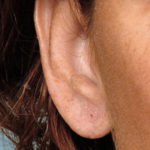The earlobes, often an after thought when thinking about the ear, is the only part of the ear that does not contain cartilage. As a result, it is much more delicate than the rest of the ear (which is supported by cartilage) and is prone to be easily torn and deformed.
Ear rings, either by their weight over time or from being accidentally (or deliberately) pulled, can easily create a complete tear resulting in a split earlobe. Sometimes the tear is not complete and a small amount of skin remains intact with a resultant very large hole. In today’s styles of ear rings, many women (and some men) have multiple holes along the earlobe. I have seen as many as five. As some women age, they desire less holes and want to revert back to a more traditional one hole centrally placed in the ear lobe.

Ear lobe piercings are even easier to remove. Once the skin is anesthetized, a small circular skin punch is used to cut out the hole(s). In a single manuever with the punch, the full-thickness of the ear lobe hole is removed. A few skin stitches closes both sides of the ear lobe, leaving a nearly indetectable small scar.
The biggest concern of most ear lobe repair patients is that the procedure will be uncomfortable. In reality, it is painless. A very small needle is used to place a few drops of local anesthetic in front of the ear lobe. In a few minutes, the ear lobe is completely numb and the ear lobe can then be injected painlessly. One should have no fear of the ear!
Dr. Barry Eppley
Indianapolis, Indiana



